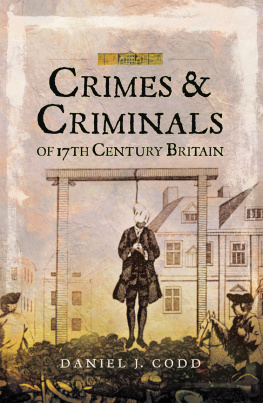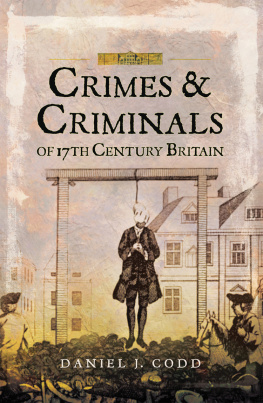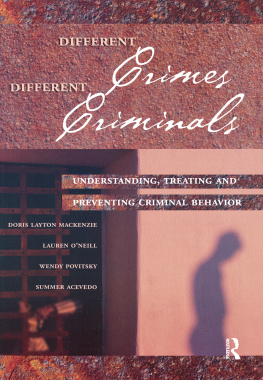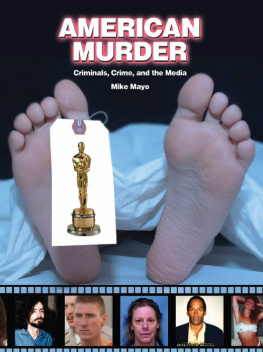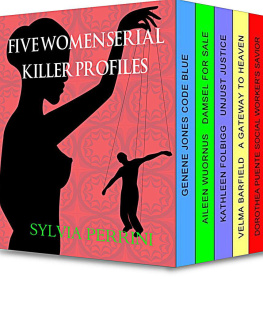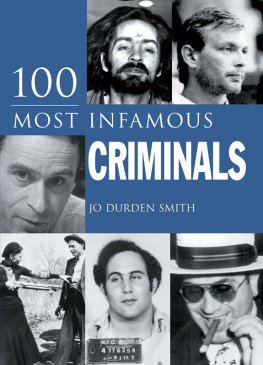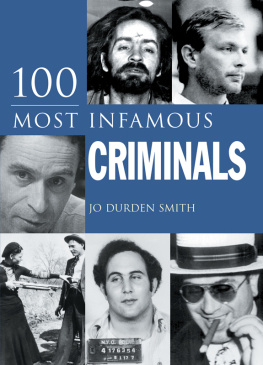Daniel J. Codd - Crimes and Criminals of 17th Century Britain
Here you can read online Daniel J. Codd - Crimes and Criminals of 17th Century Britain full text of the book (entire story) in english for free. Download pdf and epub, get meaning, cover and reviews about this ebook. year: 2018, publisher: Pen and Sword, genre: History. Description of the work, (preface) as well as reviews are available. Best literature library LitArk.com created for fans of good reading and offers a wide selection of genres:
Romance novel
Science fiction
Adventure
Detective
Science
History
Home and family
Prose
Art
Politics
Computer
Non-fiction
Religion
Business
Children
Humor
Choose a favorite category and find really read worthwhile books. Enjoy immersion in the world of imagination, feel the emotions of the characters or learn something new for yourself, make an fascinating discovery.
- Book:Crimes and Criminals of 17th Century Britain
- Author:
- Publisher:Pen and Sword
- Genre:
- Year:2018
- Rating:3 / 5
- Favourites:Add to favourites
- Your mark:
- 60
- 1
- 2
- 3
- 4
- 5
Crimes and Criminals of 17th Century Britain: summary, description and annotation
We offer to read an annotation, description, summary or preface (depends on what the author of the book "Crimes and Criminals of 17th Century Britain" wrote himself). If you haven't found the necessary information about the book — write in the comments, we will try to find it.
Crimes and Criminals of 17th Century Britain — read online for free the complete book (whole text) full work
Below is the text of the book, divided by pages. System saving the place of the last page read, allows you to conveniently read the book "Crimes and Criminals of 17th Century Britain" online for free, without having to search again every time where you left off. Put a bookmark, and you can go to the page where you finished reading at any time.
Font size:
Interval:
Bookmark:

Crimes and Criminals of 17th Century Britain
Daniel J. Codd

First published in Great Britain in 2018 by
PEN AND SWORD HISTORY
an imprint of
Pen and Sword Books Ltd
47 Church Street
Barnsley
South Yorkshire S70 2AS
Copyright Daniel J. Codd, 2018
ISBN 978 1 52670 608 9
eISBN 978 1 52670 610 2
Mobi ISBN 978 1 52670 609 6
The right of Daniel J. Codd to be identified as the author of this work has been asserted by him in accordance with the Copyright, Designs and Patents Act 1988.
A CIP record for this book is available from the British Library All rights reserved. No part of this book may be reproduced or transmitted in any form or by any means, electronic or mechanical including photocopying, recording or by any information storage and retrieval system, without permission from the Publisher in writing.
Pen & Sword Books Ltd incorporates the imprints of Pen & Sword Archaeology, Atlas, Aviation, Battleground, Discovery, Family History, History, Maritime, Military, Naval, Politics, Railways, Select, Social History, Transport, True Crime, Claymore Press, Frontline Books, Leo Cooper, Praetorian Press, Remember When, Seaforth Publishing and Wharncliffe.
For a complete list of Pen and Sword titles please contact
Pen and Sword Books Limited
47 Church Street, Barnsley, South Yorkshire, S70 2AS, England
E-mail:
Website: www.pen-and-sword.co.uk
Many thanks must go to the following: Pamela Bromley (Archivist), Warwick Castle, for her help, re the murder of Sir Fulke Greville (the images of King Charles I, the Earl of Strafford and Cromwells death mask are also used courtesy of Warwick Castle); Val Bush (Collections), Warwick Castle, for her help with Cromwells death mask; the administrators of St Marys Church, Horncastle (20 December 2015), for allowing me access and telling me about Sir Ingram Hopton; Michael Ridge, Visitor Services Assistant, Norfolk Museums Service, for help with Sir John Heydons mummified hand sadly taken off public display at Norwich Castle Museum at the time of writing, for conservation work; Reverend Kenneth Cross of St Andrews Church, Old Cleeve, and Jeanne Webb, for their help with the murder of Mr Tratte; A. Cameron (Marketing Executive), Madame Tussauds, London NW1 5LR, for permission to use the images entitled The traitors were barbarically executed in public and A pirates end at Execution Dock (see https://www.madametussauds.co.uk/london/en/ for more information on Madame Tussauds and its Chamber of Horrors); Maureen Mathias at Pembroke Castle, for permission to use the images entitled A violent street fight between Royalists and revolutionary Parliamentarians and Poyer was sentenced to death by a perverse lottery (see http://pembroke-castle.co.uk/ for more information on the Civil War Exhibition); Alice Marshall, Events Assistant, Doddington Hall, for allowing me to reproduce the image of the 1666 sea battle off the Scillies; Chethams Library, Long Millgate, Manchester, for permission to use the image of King Charles I, after his head was sewn back on (this portrait, by an unknown artist, is currently on loan to Turton Tower, Lancs); Geoff Stone, for his invaluable help with Glencoe images; Nicola Stone for her help with proof-reading, attention to detail, endless encouragement and limitless enthusiasm; Mr and Mrs Kerton, of Higher Farm, Chilton Cantelo, for allowing me to see and photograph Theophilus Bromes head; Owen Teather, for his help with the image of Rochester Cathedral; Josie Mae Skinner, for her help with the image of Marazion, Cornwall.
In particular, I would like to thank Tim Hitchcock, Robert Shoemaker, Clive Emsley, Sharon Howard and Jamie MacLaughlin, et al., The Old Bailey Proceedings Online, 1674-1913 ( www.oldbaileyonline.org ), for allowing me to cite additional information from the website in the following instances:
Law, Order and Punishment (Kelsey, the Newgate murderer): 13 June 1690, version 7.2, accessed 10 November 2015
Robbers, Bandits and Highwaymen (Golden Farmer): 22 December 1690, Version 7.2, accessed 23 September 2015
Horror Piled upon Horror (Charles Pyne): 11 July 1694, Version 7.2, accessed 19 August 2015
Why Talk to Me of Heaven? : 10 & 19 December 1679, version 7.2, accessed 10 November 2015
The Bloody Midwife (Mary Compton): 23 October 1693, Version 7.2, accessed 23 September 2015
Finally I would like to thank everyone for the kindness and generosity I have been shown at scores of libraries, museums and tourist attractions, large and small, across Britain throughout this journey of exploration, for within such places lie the half-hidden origins of books like this.
All photographs are the copyright of the author, except where otherwise stated above. All other illustrations are in the public domain.
Anyone wishing to understand what life was like during a particular era would benefit from studying the great criminal cases of the age, for these are among the best indicators as to the social, religious, political and economic doctrines that many ordinary people of the time lived their lives by, day in and day out. Their hopes, fears, beliefs, superstitions, standards of education, past-times, even their levels of compassion; all are laid bare throughout such proceedings. And so a look at crimes and criminals of the seventeenth century forces the reader to consider a curious and revealing version of todays Britain.
On the one hand, the eras populated areas may seem semi-familiar places, through the thousands of yet-existing villages, certain city street-names and a great many landmark buildings nationally, some of which were actually established in the seventeenth century, such as the rebuilt St Pauls Cathedral in London. Despite this, however, virtually all of the taverns, buildings and miscellaneous locations observed herein where heinous crimes were committed no longer exist in the form they did at the time.
This observation even applies to rural locations. Typifying this (natural) advance of history, for our purposes, is Primrose Hill, on the northern side of Regents Park site of one of the most infamous acts of the 1680s. This is the place where Sir Edmund Berry Godfreys garrotted corpse was left in a ditch, with a sword rammed through it; yet one would be hard pushed to realise it these days. In the time we are to consider, Primrose Hill was detached from the City of London by greater than two miles, formerly part of a great chase appropriated by King Henry VIII, and in the late seventeenth century still distant enough to be called the countryside. Nowadays, it has been swallowed up and incorporated into Greater London and while yet impressive, the sense of remoteness it must have presented when Sir Edmunds body was dumped here has gone forever. Its manicured grass slopes are criss-crossed with a network of paths that now accommodate all manner of joggers, kite-flyers, dog-walkers, tourists and so on. One has to leave the paths and walk west into the rougher scrubland along the perimeter of (where is now) the Barrow Hill Reservoir to come anywhere near the approximate site where, almost 350 years ago, a drama occurred that came to both horrify and disgrace London. These days, it is difficult to even sense the echo of Sir Edmunds killing, let alone imagine easily what this place must have been like when his corpse was deposited here.
Over the last four centuries, London has been redeveloped over and over, all the time spreading and growing to such immense proportions that it has now swallowed up every village, pasture and town within a 600-square mile radius. Like other cities, it was still walled at the start of the seventeenth century. Simultaneously, other British towns and villages have risen, fallen or become incorporated; ancestral homes have been rebuilt or fallen into decay; great road complexes and railway lines have opened up formerly-inaccessible parts. In some places the very landscape itself has changed through extensive deforestation, drainage, quarrying or cultivation. The point I am making is this; in most cases, the near-exact locations of the centurys horrific crimes can be reliably gauged, lending a strange familiarity to them. But it is important for the reader to consider that we are reaching so far back in history that if one could somehow be transported to the period and the locations then very few places would be immediately recognisable to us.
Next pageFont size:
Interval:
Bookmark:
Similar books «Crimes and Criminals of 17th Century Britain»
Look at similar books to Crimes and Criminals of 17th Century Britain. We have selected literature similar in name and meaning in the hope of providing readers with more options to find new, interesting, not yet read works.
Discussion, reviews of the book Crimes and Criminals of 17th Century Britain and just readers' own opinions. Leave your comments, write what you think about the work, its meaning or the main characters. Specify what exactly you liked and what you didn't like, and why you think so.

